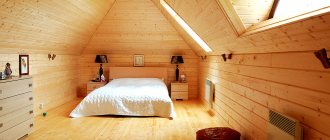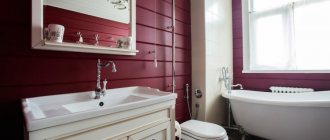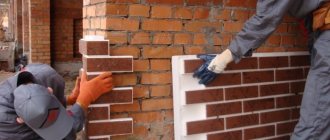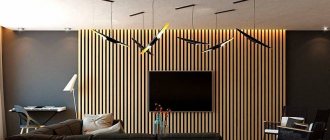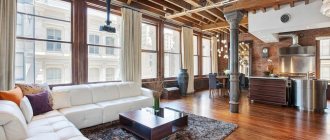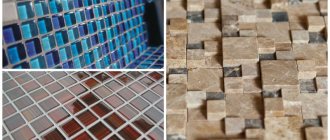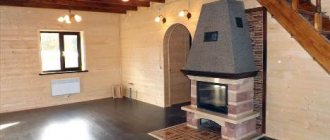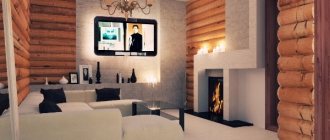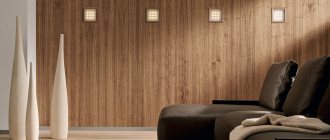Is it necessary to paint wooden walls inside the house?
Over time, when exposed to moisture, wood fibers swell and their structure is damaged. In a dry room, the wooden surface becomes deformed and cracks due to drying out. Vapor buildup in living spaces encourages the formation of mold and mildew on exposed wood. The porous, unprotected wood structure easily absorbs dirt and dust. You can get rid of such contaminants only by scraping off the top layer. And various pest bugs can literally eat a wooden building.
To prevent this from happening, and to ensure that the wooden surface retains its natural attractiveness and aesthetics, it is necessary to paint the inside of the wooden house. Modern paint and varnish coatings preserve the naturalness and strength of wood surfaces for a long time. And the variety of examples of painting the inside of wooden houses indicates the possibility of creating a unique home interior.
Most often, painting is done:
| LMB | Advantages | Flaws | Application |
| Acrylic paint | vapor permeability; durability and strength; fire safety; quick drying; ease of application; does not emit toxic fumes; can be matte or glossy; suitable for artistic painting; rich color palette; resistance to fading in the sun; practically does not change its color after application; not fussy to use. | completely hides the texture and color of the wood (however, this is advantageously used in design); limited scope. | walls; ceiling; floor (floor paint). |
| Water based paint | vapor permeability; good protective properties; wide range of applications; does not hide the natural appearance of the wood, and you can change the shade of the wood. | needs stable conditions for painting and drying; does not hide scratches and other defects. | floor (does not create significant film or shine); walls; stairs; furniture; elements of wood trim, windows and doors. |
| Oil-wax | a completely natural alternative to varnish; unlike varnish, it creates a surface that is less slippery and warmer to the touch; allows for local coating repairs; hides scratches; the oil has good antiseptic properties; noble look. | requires frequent and special care; needs frequent updating (about once every 3 years (depending on the surface, possibly more often)); after impregnation with oil, other paints and varnishes will not lie on the surface. | parquet; stairs; furniture. |
Acrylic paint
It is carried out in at least several layers. First, cleaning should be carried out, which may include grinding and priming the surface. To completely cover the walls, you can use a roller or spray gun. The brush is suitable for primary painting in hard-to-reach areas and for artistic painting.
Recommendations:
- To prevent the paint from becoming unusable due to rapid drying, do not dilute it in its “original” jar, but pour it into another container.
- To paint with acrylic, the brush should be hard and elastic; it is better to use nylon brushes.
Water based paint
It requires careful adherence to the technology of processing a wooden house with this particular material.
Varnish can only be applied to well-dried, sanded, leveled and cleaned wood. Interior painting of a wooden house with varnish is ideally carried out at temperatures from 18 degrees to 21 without changes. Recommended air humidity is from 40% to 50%. Drying too quickly or too long will ruin the coating. Open windows and drafts are not allowed when the varnish is curing. Recommendations:
- To maintain the necessary climatic conditions in the room, you can use special humidifiers for dry rooms or, for example, heat guns for wet ones.
- Any paintwork materials must be thoroughly mixed and then wait 5-10 minutes before applying.
- Air bubbles in the varnish are removed by scraping, which can be done before applying the finishing coat.
Oil-wax painting of wooden floors
This composition is usually recommended for painting wooden floors inside the house. Application technology – hot or cold. The first is more effective, since the oil penetrates well into the wood and deeply saturates it. The number of layers is 2, and when working with a tinted composition, the finishing layer should be colorless. The technology for painting a wooden house with oil and wax requires removing excess wax and polishing the surface with natural lint-free fabrics. If oil is applied separately from wax, the floor may need to be re-treated several times until the wood is sufficiently saturated. Recommendations: Tinted oil-wax should be constantly stirred during the coloring process, because paint pigments fall down.
Choosing products for painting the inside of a wooden house
Paints and varnishes for interior painting of a wooden house must be compatible with wood, be environmentally friendly and safe for human health. Typically these are paints and varnishes based on water or natural oil, such as hemp or linseed. For high-quality interior finishing, paint and varnish coatings are selected taking into account the temperature and humidity of the room being painted, the degree of load on the wooden surface and resistance to cleaning chemicals. The vapor permeability of the coating, allowing the wood to “breathe,” improves air exchange and maintains a comfortable level of humidity in the room. Varnishes and paints with a high level of moisture resistance are used when finishing kitchens and bathrooms. Increased wear resistance of polyurethane-based coatings is necessary for painting stairs and floors. Antistatic, which does not allow dust to accumulate, will simplify cleaning of rooms.
The natural beauty of wood fiber is emphasized by glazing (transparent) coatings: matte and semi-matte, glossy and semi-gloss. Colored varnishes and paints help create a unique design or accentuate details.
Materials for preparing and painting wood for interior decoration
Solutions for preparing wood for painting
The entire process of preparing wooden interior wall surfaces for painting consists of three stages - cleaning, sanding and treatment with protective agents.
Before moving on to the characteristics of paint and varnish decorative compositions, it is necessary to first consider solutions designed to protect wood from negative influences that destroy its structure, such as high humidity and ultraviolet rays, from damage to the material by various harmful insects, mold, fungus, moss and other parasites representatives of microflora. Some solutions include not only antiseptics, but also fire retardants, which are designed to significantly reduce the risk of wood fire in the event of emergency fire situations.
So, before painting, the wood must be treated with special antiseptic agents.
When purchasing a solution for primary wood treatment, be sure to pay attention to the permissible area of application of the composition
When purchasing one of the protective solutions available for sale in a fairly wide range, you need to pay attention to the packaging label (label). It must indicate the area of its application, that is, a specific composition is intended for internal or external work.
Protective compounds can be transparent, preserving the completely open texture of the wood or giving it a glossy brightness or soft matte finish. However, there are also tinting solutions that make the material one or more shades darker.
There are several types of different solutions that can be intended to protect against various negative influences on wood - these are conventional and biomoisture-protective antiseptics, fire retardants, bleaching and primer compounds. To understand how they differ, it is advisable to consider each of them. This will make it easier to make the right choice.
Prices for wood antiseptic
antiseptic
- Antiseptic solutions are designed to combat fungus and mold that have appeared on wooden surfaces, as well as to prevent the formation of new formations. These compositions, in turn, are also divided according to different criteria.
An example of a high-quality antiseptic with a tinting effect.
So, you can find two types of antiseptics on sale - impregnations and coatings:
— Impregnations are designed to penetrate deeply into the wood structure. When purchasing this version of the solution, you need to carefully study its composition, since some of these treatment agents are very toxic;
— Coating solutions create a film on the surface of the wood and protect it from moisture. They are especially relevant for covering walls in rooms with high humidity, for example, in a bathroom or bathhouse.
Antiseptic solutions are produced on different bases, and according to this criterion they are divided into the following:
— Water-soluble compounds are environmentally friendly, so they are excellent for treating indoor walls. They are usually used under paints that are also water-based. A significant disadvantage of such antiseptics is that over time their protective qualities decrease.
— antiseptics made on an organic basis have high protective properties. However, they are more suitable for the facades of wooden houses, since they contain toxic components and are also unsafe in terms of flammability during application and before drying.
— Oil solutions of antiseptics are most often used for facade surfaces, wooden cladding of a balcony or loggia, especially if the house is located in a region with a harsh climate.
— Combined solutions consisting of oil and high-carbon components are used to treat both external and internal wooden surfaces. Moreover, they are also suitable for rooms with high humidity, providing their surfaces with high-quality protection.
The last option of antiseptics is the most expensive, since, in fact, it becomes a universal remedy used in any areas of construction and finishing.
- Biomoisture-protective antiseptics are used as an effective measure of protection against fungal growths, mold and insects harmful to wood. This type of antiseptic creates a protective barrier on the surface of the wood and also serves as a decorative coating. Therefore, the biomoisture-proof solution can be called universal, since it performs two functions at once.
One of the means for effective bio-moisture protection of wood - but it is more suitable for outdoor work.
Thanks to these properties of the antiseptic, not only money will be saved, but also time for painting. It is these solutions that are in high demand among owners of wooden houses.
- Fire retardants are used to make wood more resistant to fire, that is, material treated with such a composition is able to withstand exposure to open fire for a long time without igniting.
The main disadvantage of wood is its low resistance to fire, and treatment with fire retardants helps reduce the risk of fire.
Fire retardants are divided into two groups according to their reaction to fire:
— One group of solutions contains salts, due to which, when wood is exposed to high temperatures, gases are released that can prevent rapid combustion.
— The second group of fire retardants blocks flames by foaming, which occurs when wood is heated to elevated temperatures and creates a protective coating on it.
More effective fire retardants, according to experts, are those that contain sodium salts, as well as orthophosphoric, pyrophosphoric and tripolyphosphoric acids.
- Biopyrenes are impregnations that combine the functions of both a fire retardant and an antiseptic. Similar solutions can be used to treat walls from the inside and facade.
Binary action impregnation - provides both biological and fire protection for wood.
Due to the fact that this product is a complex consisting of all the components necessary to protect wood, using it you can save some money, time on work and on waiting for several different layers to dry out. solutions. So the costs are likely to be justified.
Biopyrene prices
biopyrene
- primer is another effective protective agent used for preparatory work before painting. These solutions are not only designed to prevent various manifestations and effects destructive to wood - they also create good adhesion between the surface of the wooden wall and the applied decorative layer. Water-based wood primers can be transparent, translucent or opaque. According to this criterion, they are selected depending on what effect is planned to be obtained as a result.
The use of primers greatly simplifies the subsequent process of applying paints and varnishes.
For example, if you plan to paint primed walls with a thick layer of paint, then it does not matter what kind of transparency primer to cover the wood with. In this case, rather, you only need to take into account that an opaque version of the soil will give a smoother surface. Transparent compounds work like impregnation, penetrating the structure of the material and filling its pores, but they do not have the property of creating a protective layer on the surface of the wood.
However, whatever primer is used, it creates a good base for the wood and paint to adhere to.
- Wood bleaching products are used to remove various manifestations from its surface that spoil the appearance of the entire wall - these can be blue, streaks or dark spots. Simultaneously with the removal of the above-mentioned flaws, these compositions also perform a protective function.
When using bleach, you must strictly follow the instructions provided by the manufacturer.
Bleaching solutions can be one- or two-component. The second version of the compositions is combined and mixed immediately before applying them to the wood. The formulation of some of the products provides for them to be washed off after a certain period indicated on the packaging, while others remain on the wood for painting as an antiseptic. Therefore, before purchasing one or another type of bleach, you need to pay attention to the packaging, which contains instructions for using the solution.
Varnish as a protective and decorative agent
As a protective agent for wooden walls, in addition to the above mentioned products, varnish solutions are used, which can also be made on various bases. To know which of the existing varnishes are suitable for indoor use, you need to consider each of them in more detail:
Varnishes are one of the best means for protecting and at the same time decorative coating of natural wood.
- Acrylic varnish consists of polyacrylates and is organic or water based. The solution is an environmentally friendly product without a pungent odor, and therefore it is often used to cover the surfaces of not only wooden walls from the inside, but also furniture.
Acrylic varnish - fits perfectly on the surface of wood, but, unfortunately, is not resistant to abrasive loads.
However, it must be taken into account that the layer formed by this type of varnish is not highly resistant to abrasion. This means that the coating will have to be updated quite often, and this is especially true for furniture accessories.
- Polyurethane varnish is made on a water basis, but despite this, it has high strength characteristics, including abrasion resistance. The composition of this protective agent is environmentally friendly and almost completely odorless after drying, so it is perfect for application to wooden walls inside the house.
Polyurethane varnish is highly resistant to abrasion - it is suitable even for wooden floors.
Some experienced craftsmen recommend adding hardening agents to the polyurethane solution to extend the life of the finish. Due to its high strength characteristics, this varnish is often used to cover wooden floors and parquet, so it is also fully suitable for walls. However, the price of these products is quite high, and this factor is the main disadvantage of this material.
- Alcohol varnishes and polishes can create a durable glossy layer on the surface of wood. However, despite their high strength, compositions based on this basis are not resistant to moisture, so they cannot be used to cover walls in bathhouses, loggias and balconies, as the coating layer will begin to peel off.
Varnishes are made based on natural resins, so their prices are quite high. This circumstance, coupled with low moisture resistance, determines that such compositions are not in high demand.
- Nitrocellulose varnishes consist of organic solvents and cellulose nitrate with the addition of synthetic resins to the solution.
Nitrocellulose varnishes are durable and quick-drying, but extremely flammable and have a strong odor until completely cured.
This type of varnish is divided into two varieties:
— One of them is intended for preparatory work, that is, it creates the basis for the outer layers.
— The second one is itself a decorative coating.
They are distinguished by the digital markings applied to the packaging. Typically, preparatory solutions have the property of drying quickly - this quality is provided by the manufacturer to avoid delays in the work. Therefore, when purchasing this composition, you need to pay attention to the instructions printed on the packaging with varnish.
Nitrocellulose solutions create a fairly durable coating layer on the surface of wooden walls, which is transparent and therefore does not change the natural color of the wood. Therefore, if you intend to preserve the beautiful textured pattern of the internal surfaces of wooden walls, then this type of varnish is well suited for this purpose. True, it is necessary to work with such compositions with special caution - they are extremely flammable in their uncured form (before the nitro solvent evaporates), and will emit a pungent odor before drying.
- Oil varnishes are made on the basis of artificial or natural resins; in addition, they also contain modified natural oil, driers and solvents. Varnishes of this type penetrate well into the wood and form a durable protective layer on its surface, giving the wood a warm ocher tint.
The solutions are well suited for interior finishing work; they cover wooden walls, floors, and furniture.
- Alkyd varnish is made on the basis of glyphthalic or pentaphthalic resins, to which driers are added. Since this type of varnish contains oils used as solvents, they are also often called oil-based. However, the alkyd version of varnish differs from oil varnish in its higher physical, technical and operational characteristics, so it is successfully used not only for interior but also for exterior decoration.
Some of the most popular and affordable varnishes are pentaphthalic-based alkyd varnishes.
In addition to alkyd varnishes, alkyd-urea solutions consisting of alkyd and amyl-formaldehyde resins are also available for sale. This type of varnish can be called two-component, since its drying is only possible when acidic hardeners are added to the mixture. This varnish is mixed immediately before applying it to the surface of the wood, since after preparation the solution remains suitable for a very limited time, and after it has hardened it will no longer be possible to dilute it.
This type of varnish is easy to apply and, after hardening, forms a durable protective layer on the surface that is highly wear-resistant. Thanks to this property of alkyd-urea varnish, it can be used not only for covering walls indoors, but also for covering parquet.
Paints for finishing wooden walls
In order to paint the inside of a wooden house, paints made on any base are suitable. Nowadays, various types of this material are presented in specialized stores in a very wide assortment. And one of the most important criteria when choosing a composition should be its safety, that is, the paint should not emit harmful toxic substances both during its application and during use of the premises.
Therefore, when purchasing any paint and varnish material, you need to pay attention to its characteristics, which should be presented on the packaging. In addition, it is recommended to obtain information from a sales consultant.
So, in specialized stores today you can find the following paints for finishing wooden surfaces:
- Water-based compositions are quite popular, since with their help you can cover the wood with a thick layer of paint, or you can make it translucent, thereby preserving the textured pattern of the wood. If the latter option is chosen, the paint must be diluted with water to the required consistency.
Water-based paints are attractive due to their low price and versatility, but are not durable - they cannot withstand abrasive loads.
Water-based solutions are distinguished by the absence of a sharp unpleasant odor and the fact that they do not emit toxic fumes harmful to humans. Therefore, they can be safely called an environmentally friendly material. The layers applied to the prepared surface set well and dry quickly, but are inferior to varnishes in their strength and wear resistance.
Prices for silicone paint
silicone paint
- Silicone paints are a solution of silicone resins, and thanks to them, they create a reliable and durable coating on the surface of wood. The paint composition has excellent technical characteristics, it is inert to mechanical stress and has good vapor permeability, that is, it allows wooden walls to “breathe”.
Some of the most durable and practical to use are silicone paints.
Moisture-resistant silicone film is resistant to abrasion and ultraviolet radiation. The applied coating is distinguished by enviable durability and is not only protection for the wood, but also a way to hide some flaws on its surface. The coating does not crack when the walls shrink, as it has good ductility.
- Silicate paint compositions are made from “liquid glass”, and therefore have a large number of positive characteristics. They are highly resistant to ultraviolet rays, high humidity, low and high temperatures, as well as open fire.
Silicate paints have a very beneficial effect on the atmosphere in the house, due to their environmental friendliness and high vapor permeability.
Silicate paint is an environmentally friendly product, since it does not contain substances harmful to humans and does not emit toxic fumes. Therefore, this type of material is excellent for covering internal surfaces, not only wooden ones, but also those made of other materials. Considering all the characteristics of this finishing material, we can conclude that it is well suited for rooms where conditions may arise that increase humidity, for example, an unheated balcony or veranda.
True, silicate compositions are completely incompatible with finishing solutions made on a different basis. That is, in case of repainting, it is necessary either to use silicate paint again, or to clean the surface to the very base.
- Acrylic paints are water-based, but have characteristics that exceed those of oil-based compositions, and therefore are able to provide reliable protection to wood and preserve its natural color. Due to their elasticity, paints have excellent adhesion to surfaces; they do not deform or crack.
High-quality acrylic paints are an excellent solution for interior decoration.
Paint can be used to paint both internal and external surfaces of a building.
- Alkyd enamel is used for painting both facades and interior wall surfaces. It creates a protective glossy or matte layer on the wood, making it smooth and aesthetically pleasing.
However, this composition also has its drawback - over time, alkyd white enamel turns yellow, and paint that has color fades, so to paint walls, for example, a balcony located on the sunny side, or that constantly receive a “portion” of sunlight, use it is not recommended.
- Oil paints have a considerable number of advantages over other compositions and are suitable for both internal and external coating of wooden surfaces. High-quality solutions are highly resistant to external mechanical influences and high humidity.
The obvious disadvantages of oil-based paint compositions include their long drying period, low resistance to ultraviolet radiation (over time, the coating begins to crack and peel) and air tightness. This type of paint is most often used to cover facade surfaces, but even then - with fairly frequent updating of the finish.
- Natural wax paints or liquid wax are made on a linen base and have been used to coat wood for decades, so they can be called a traditional material. Wax is well absorbed into the wood structure, making it waterproof.
Wax paints - create a pleasant matte wood surface, well protected from moisture penetration.
The solution can be transparent or tinted.
If you plan to preserve the original color of the wood, then choose a transparent wax option, and if you need to darken the wooden walls, then you should use a tinted solution. Wax paint is easily applied to the surface, but acquires the chosen shade only after complete drying. Therefore, it is recommended to first apply a similar composition to a small area of the wall and wait for it to dry to make sure that the optimal paint tone is chosen.
Paint selection
The creation of a unique interior is influenced by the color scheme of painting wooden walls inside the house. A soft combination of matte surfaces in calm, harmonious colors is used in bedrooms. Bright gloss is best used in kitchens or living rooms. In addition, glossy surfaces are easier to clean. Colorless impregnations or varnishes emphasize the natural beauty of the fibrous structure of wood.
Powdered water-soluble stain allows you to give the painted surfaces the natural noble colors of valuable wood species. A greater or lesser concentration of powder regulates the color intensity. When using stain, it is important to cover the entire surface with the solution at one time, without changing the composition or interrupting it. Otherwise, there is a high probability of getting a non-uniform coating. Stain, like other water-dispersion paints, allows the wooden surface to breathe and does not leave any odors.
A varied palette of acrylic paints is used to create contrasts and rich accents in the interior, helping to embody bright, bold design fantasies. By forming a protective film on the painted surface, acrylic coatings preserve the wood and do not fade for many years.
The feeling of peace and security is created by the matte surfaces of oil paints.
Design for painting walls inside a wooden house
Experienced designers recommend making a decision on the color design of a house after considering various photos of painting a wooden house inside and taking into account the influence of colors on the human psyche.
Visually expanding the space of a small room, white in excess can make the interior uncomfortable and boring. The revitalizing color orange combines harmoniously with both stimulating red and energizing yellow. Violet stimulates calm mental work, and in blue walls the concentration of attention is much higher. Any shade of green will help you tune into a lyrical mood.
To diversify a fashionable interior, painting one of the walls of the room in a brighter contrasting color, obtained by adding more color to the paint, helps.
Color harmony
Numerous photos of painting walls inside a wooden house prove the need to combine the color of the walls and flooring with the color of the furniture. When drawing up a room project, you must follow some rules of color compatibility:
- Light beige walls will be set off by a floor in light brown tones.
- The greenish-blue tones of the flooring harmonize perfectly with the golden walls.
- Greenish tones with light gray shades on the walls look harmonious with a light gray floor.
In addition, light orange, golden or ocher tones are recommended for rooms with north-facing windows. Greenish-blue colors are recommended for “southern” rooms. A variety of color combinations can be seen in numerous designer photos.
Fashionable colors
Fashion will tell you what color to paint the outside of your house. Dark colors are popular now. The favorite color is black, which gives the appearance of the house sophistication and unusual style. Black color is especially often used to decorate wooden buildings. If black seems gloomy, the facade of the house can be painted dark brown or beige.
White, gray or blue are still popular. And there is a reason for this choice: white can be combined with any color, and gray or blue is an excellent base background for highlighting other parts of the home with brighter colors. Such specimens are often found throughout Russia and the CIS. Light yellow or pale orange are often used instead of white or beige.
Of course, for houses with a red roof, it is better not to make a façade of the same shade. But if the roof is gray, red or orange paint will work well on the walls of the home as the main background and will help the building stand out.
Painting options for inside a wooden house
Painting wooden walls inside a house is possible in two ways:
- A perfectly smooth surface obtained using the first method will retain its attractive appearance for at least ten years, but will require large financial and time costs. With this method, the wooden surface is sanded twice: roughly and finely. Next - treatment with an antiseptic, primer and two-layer coating with varnish or paint by spraying.
- In the second method, the surface is roughly sanded, treated with an antiseptic and painted in two layers. After 5-6 years it is simply painted. This method is more economical and faster.
Painting tools
To paint the inside of a wooden house yourself, you must have experience in painting work and the appropriate tools and materials, such as:
- Wire brush, spatula or sander. Will be needed to remove old paintwork.
- Wide brush (flute), roller and spray gun. They will speed up the painting process and ensure the quality of the coating.
- Primer for wooden surfaces.
- Respirator, gloves, safety glasses. Prevent paint and varnish products from getting into the eyes, respiratory tract and exposed skin.
- Selected decorative paint coating.
High-quality paint should not be removed. It is enough to select the same paint as was used previously and apply a fresh coat. The type of old coating is determined by the type of cracking: oil paint produces mesh cracks, acrylic paint produces long longitudinal cracks.
Estimation of financial costs
Here are several blocks of information that will be useful when assessing the financial costs of painting a wooden house.
First block: list of consumables for different types of paints.
Acrylate paints:
- putty;
- antiseptic (optional). Average consumption 60-100 g/m2;
- primer (consumption 150-200 ml/m2);
- paint (from 100 to 130 g/m2);
- brushes or rollers (if you don’t have a spray bottle).
The composition of consumables for applying oil paints is the same as for acrylate paints, plus a solvent (solvent or white alcohol).
Glazing oil impregnations:
- oil of the required type (antiseptic has already been added, no primer is needed). Average consumption 70-100 g/m2;
- brushes
When choosing the appropriate combination, keep in mind that the consumption figures given are for one layer. The recommended number of layers for both primers and paints is two.
In the second block we list the average maintenance-free service life of coloring compounds:
- acrylic and latex based paints – 8-10 years;
- oil paints – 4-5 years;
- impregnations based on natural oils - it is recommended to update every 3-4 years.
Stages of painting work
- Purchase of necessary tools, protective clothing and protective equipment, selected paint and varnish coating.
- Preparing a wooden surface for painting: cleaning and sanding.
- Impregnation with moisture protective agents, antibacterial agents and fire retardants.
- Application of primer and decorative painting.
Experienced finishers know that 3-in-1 protective products are less effective for long-term preservation of wood, as is the use of a primer with antiseptic properties. It is recommended to apply each new layer of protective impregnation after the previous product has been absorbed.
Preparing to paint wooden walls inside the house
Both in a new, newly built, and in an old wooden house, painting the walls inside requires careful preparation.
- Use brushes, a spatula or a grinder to remove dust, dirt or remnants of the old, swollen paint coating. Sometimes a hot hair dryer or chemicals are used to remove cracked layers of paint.
- If mold or mildew is detected, the infected areas are treated with special means.
- Damaged slats, boards, planks and other elements of wooden finishing are replaced with new ones.
- The wood surface to be painted is sanded to prepare for subsequent finishing and to highlight the natural beauty of the wood grain.
- Treatment is carried out with agents against rotting, bugs and fire.
High-quality preparation of the wooden surface guarantees long-term preservation of the beautiful coating.
Preparation - like the first stage of painting
Having decided what paint to paint a wooden house, you can proceed directly to painting. The first stage of painting is preparatory work. After all, if you miss this step, in the end all your work will not bring you the expected results.
Initially, you need to thoroughly clean the surface on which the paint will be applied. It is advisable to do this in advance so that the surface has time to dry. Afterwards, you need to cover all areas that will not be used so that paint does not accidentally get on them. If there are any defects on the tree, they must be eliminated.
For example, cracks can be repaired with putty, but rotten wood needs to be replaced altogether. If mold or mildew is present, it is also worth taking active action. To begin with, remove the damaged surface, and only then treat it with an antiseptic.
Treat the cracks with sealant, and if the nails are not completely pressed into the wood, then do this and treat them with putty. If you miss this moment, then the paint for the interior decoration of a wooden house around the nails will be darker.
Preparing for painting
Before painting, paint for a wooden house inside must first be mixed in a closed jar, and then in an open one. Having completed all these steps, you can move on to the next stage.
Painting walls inside a wooden house
Following some simple rules when painting wooden surfaces ensures a high quality finish.
- Painting inside a wooden house should be done in warm weather and with good ventilation.
- Uniformity of color and gloss of the coating is achieved by thoroughly mixing the varnish or paint.
- When applying a thin layer of paint from top to bottom, smudges do not form.
- Protective impregnations, primers and decorative layers must be applied along the wood fiber.
- Each new layer is applied after the previous product has absorbed or dried.
- The beauty and durability of the coating is achieved by applying at least two decorative layers of paint or varnish.
- It is advisable to apply paints and varnishes using a spray gun. However, if you do not have the appropriate skills, it is better to entrust painting work to professionals or use a roller and brush.
High-quality painting of a wooden house from the inside preserves the integrity of wood surfaces, extending their service life. It also helps to create original interiors in a wide variety of stylistic solutions.
Life hacks: the best way to paint the inside of a wooden house and how to do it with minimal labor costs
After solving the basic questions - what paint is better to paint the inside of a wooden house, what shade to choose, how to prepare the surfaces - and calculating the required amount of materials, it’s worth learning a few more “tricks”.
- After sealing defects with sealant, priming the surface is mandatory, otherwise the paint will be strongly absorbed into the sealant, creating uneven tone and increasing consumption. If the sealant is tinted (with special pigments), the color of the surface will be more even and richer.
- The masking tape must be checked for tightness before painting. If necessary, the “waves” should be pressed with a spatula.
- If a large amount of work is planned, the paint can be thinned a little. Choosing an air conditioner (thinner) should be done at the same time as deciding how to paint the lining inside the house. Thinner paint will go on smoother, without rough strokes or joints, but will dry more slowly.
- Surfaces are painted alternately. Applying paint with a brush or remote control to all surfaces and “rolling” them one by one with a roller, you may not have time to even out the layer of paint on all finishing elements.
- In one batch of paint (stains, tinting coatings) there may be slightly different colors. Before starting work, you should mix the contents of all packages to obtain a single color.
- Rollers and brushes should be washed before starting work. If the question of how to paint the lining inside a country house has been decided in favor of a water-soluble product, it is not necessary to dry the tools - you can start painting right away. To manipulate coatings on a different base, it is better to dry your brushes and rollers.
Professional secrets
The same varnish or paint looks completely different on different surfaces. Before painting, it is recommended to do a test on a small piece of the wall, stairs or floor.
When creating a painting design for the interior of a wooden house, it is necessary to select a color for painting open pipes or heating radiators, since they, being functional interior details, must be in harmony with the color scheme of the entire room.
Two thin coats of paint will last longer than one thick coat.
Varnish or paint is removed from leather with vegetable oil. Just rub a few drops into the stained area and rinse with water after 10 minutes.
Caring for painted surfaces
With proper care of a painted surface, its decorative qualities and protective properties are preserved. Wooden structures tend to look sloppy when they try to paint over stains caused by using inappropriate detergents or excessive rubbing.
Here are some tips for caring for painted wood:
- You should avoid cleaning and treat the painted surface very carefully for two weeks, since the paintwork dries completely and reaches maximum wear resistance only after 7-10 days.
- Wiping water-based or water-dispersion coatings with a wet cloth washes away the top layer of paint, forming streaks and exposing the wood base.
- On glossy surfaces, dust is less noticeable and it is easier to care for them by periodically wiping with a damp or dry cloth.
- Painted surfaces in the kitchen, toilet and bathroom are wiped with a cloth soaked in water at a temperature of 40-45 degrees (not higher than 50) with the addition of special products for the care of painted surfaces, and then wiped dry. Matte spots on the surface appear after using soda or cleaning powders.
- Before washing, it is recommended to sweep or vacuum painted floors and rinse with a well-wrung out cloth. To improve the appearance and provide additional protection from moisture, the floor is rubbed with wax or special mastic.
- The ceilings in the house are the least likely to get dirty. To care for them, use dry or slightly damp rags and brushes, as well as a vacuum cleaner.
